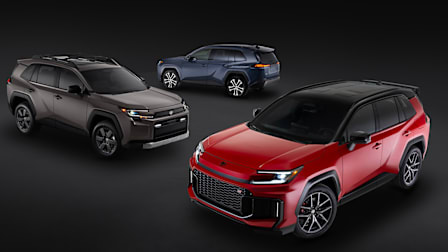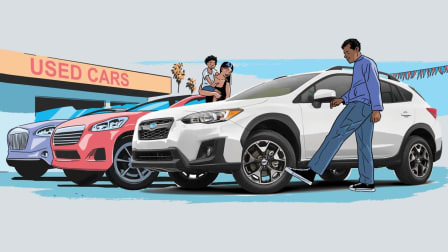Preview: 2024 BMW 5 Series Introduces i5 Electric Sedan, Offers Optional Hands-Free Driving
A plug-in hybrid model will join the line next year
Update: Since this preview was originally published in May, 2023, we bought and tested the BMW 5 Series and i5. Read the complete BMW 5 and i5 road tests.
BMW introduced its new, larger 5 Series sedan this week, its most notable change being the addition of all-electric and plug-in hybrid variants. It appears to be part of BMW’s recent strategy to offer both gasoline and electric models of its most popular models. Even the two gasoline-powered versions get some electrical assistance from a 48-volt mild-hybrid system.
CR's Take
The 5 Series has historically been a driver’s car, although the outgoing version traded some of that engagement for luxury and plushness. BMW promises that the new version—whether powered by a gasoline engine or electric motors—promises to recapture that tradition.
Our experience with the i7 has shown it to be a more polished version of what some other EV manufacturers have brought to market. We anticipate that level of sophistication to carry forward to the i5. A smooth ride, great handling, outstanding interior and exterior fit and finish, and sporty driving dynamics are what you would expect from a BMW. We look forward to testing one to see how the i5 measures up.
Beyond traditional BMW driving characteristics, we hope to see continued improvement with controls. Despite some progress with recent BMW models, CR testers have found that there are still a number of minor annoyances that get in the way of full enjoyment—among them confusing, menu-based controls.
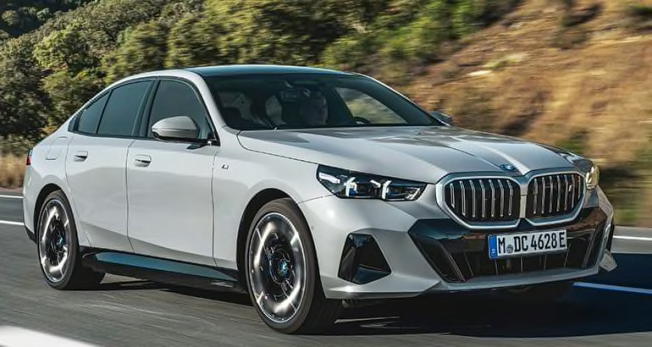
Photo: BMW Photo: BMW
Outside
The new 5 Series is larger than its predecessor—3.4 inches longer, 1.3 inches wider, and 1.4 inches taller. Despite its growth, it still looks much the same as it did. The car’s overall look hews to tradition, its design incorporating the familiar kidney-shaped twin grilles, a squared-off interpretation of the signature four round headlights (albeit LEDs now), and long, L-shaped tail lights.
The body sides have been smoothed out somewhat, but bulges on the hood extending back from the grill openings (or, in the case of the EV version, vestigial grille panels) are a bit more pronounced. Standard wheels are 19 inches, but larger wheels, up to 21 inches, are available.
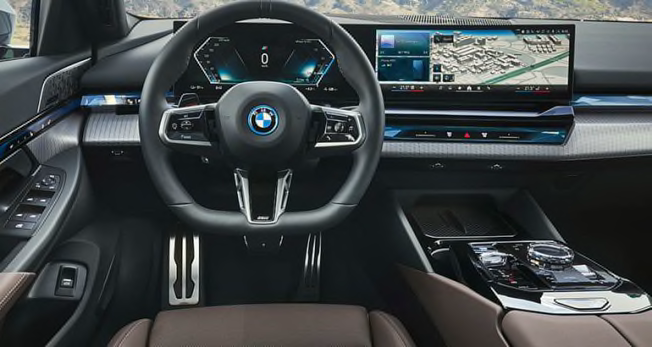
Photo: BMW Photo: BMW
Inside
The interior of the new 5 Series looks high-end and high-tech, with the dash centered around a 14.9-inch touchscreen that—despite its size—manages to blend in and not look as if it were a tablet tacked onto a dashboard. The driver’s instrument panel consists of a 12.3-inch screen behind the steering wheel. The system includes a head-up display, and can be outfitted with an in-car gaming console. Electric models come standard with the “interaction bar”—a customizable backlit control strip that runs the length of the dash—also seen on the 7 Series. That feature is optional on gasoline-powered models.
Leather, metallic accents, and soft-touch surfaces abound. For those who feel guilty about leather, BMW offers an optional leather-free interior. Like the i7, BMW appears to have hid the climate control vents below a metallic accent spear that runs along the dash. It’s a chic look to be sure, but may place the vents too low for some drivers’ comfort.
The slide-and-tilt moonroof is standard across the model lineup, but it can be swapped out for fixed panoramic glass that covers most of the roof area.
A benefit of the car’s larger overall size is a bigger rear seat. A large drop-down screen and small touchscreens for rear seat passengers (all optional) add to its premium feel. The door pockets and console offer ample space for storage, although the front door pockets are partially covered, and could make it easy to lose track of small items that slide to the rear.
At more than 17 cubic feet, the trunk is large, and the rear seats fold in a 40-20-40 configuration (the center armrest folds independently of the rest of the seat) to accommodate longer items.
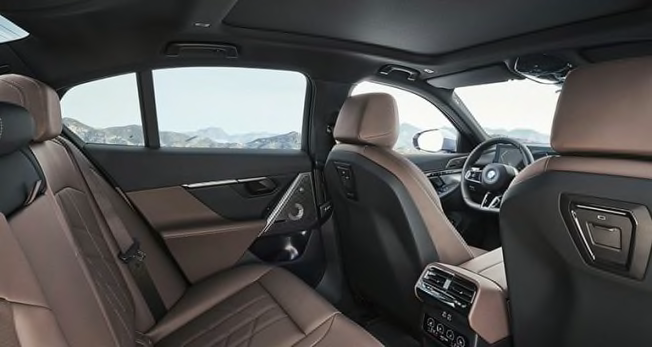
Photo: BMW Photo: BMW
What Drives It
The new 5 Series is available either as a conventional gasoline-powered model or as an EV. BMW hasn’t yet released details about the plug-in hybrid version. The two gasoline engines offered are updated versions of the four- and six-cylinder models that BMW has been using for years.
The 2.0-liter turbocharged four-cylinder engine has a peak power output of 255 horsepower and 295 lb.-ft. of torque, up a few points from the outgoing model. BMW says four-cylinder models will go from 0 to 60 mph in 5.9 seconds. The 3.0-liter turbocharged inline-six engine supplies 375 hp and 384 lb.-ft. of torque, also an increase over its predecessor. BMW says the six-cylinder model will accelerate to 60 mph in 4.5 seconds. Both gasoline models will also be outfitted with a 48-volt mild-hybrid system that can give a momentary boost of torque during acceleration.
Both the four- and six-cylinder models feed power to the wheels through an eight-speed automatic transmission equipped with steering-wheel-mounted paddle shifters. The four-cylinder model is available in rear- or all-wheel drive, and the six-cylinder comes standard with all-wheel drive. EPA fuel economy estimates for gasoline models are not yet available.
The electric powertrain comes in two configurations: a single-motor with rear-wheel drive or a dual-motor version with all-wheel drive. The single-motor i5 eDrive40 produces 335 hp and 295 lb.-ft. of torque. Motor torque can be temporarily boosted with Sport Boost and Launch control modes. BMW says the eDrive40 will accelerate from zero to 60 mph in 5.7 seconds. The all-wheel-drive i5 M60 xDrive has an electric motor at each axle for a combined output of 590 hp and 549 lb.-ft. of torque that can be temporarily boosted to 605 lb.-ft. at the touch of a button. BMW says the M60 xDrive will accelerate from 0 to 60 mph in 3.7 seconds.
All i5 variants come with an 84 kWh battery pack. EPA range estimates for the i5 are not yet available, but BMW estimates that the i5 xDrive40 will go 295 miles on a charge on standard 19-inch wheels, and the M60 xDrive will go 256 miles. The i5 comes with a Max Range mode that limits power and other vehicle functions to conserve battery power. BMW also estimates that when the i5 is connected to a 205 kW DC fast charger, it will be possible to go from 10 percent to 80 percent charge level in about 30 minutes, which is competitive. First-time i5 owners will get a two-year subscription to Electrify America’s DC fast chargers.
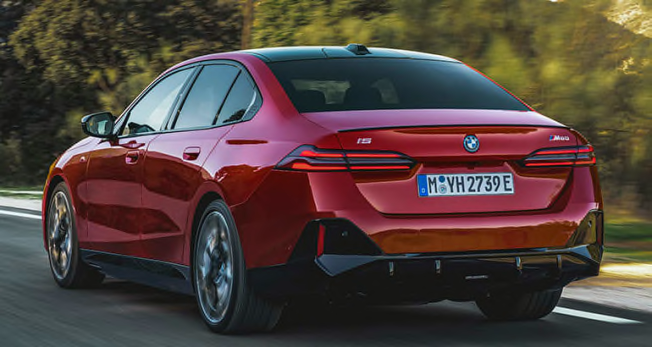
Photo: BMW Photo: BMW
Active Safety and Driver Assistance
Both gasoline and electric 5 Series models will come standard with a suite of active safety and driver assistance features, including automatic emergency braking, blind spot warning, rear cross traffic warning, and lane keeping assistance (LKA).
There are several features included in the optional driver assistance package: Adaptive cruise control with hands-free driving that works at speeds up to 85 mph; LKA with a feature called side collision protection that will steer the vehicle to the side if another car gets too close; a lane change assist that activates when the driver looks to the side; an evasion feature that will identify imminent collision hazards and steer the car into a clear zone; and front cross traffic warning.


















